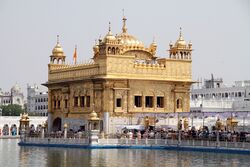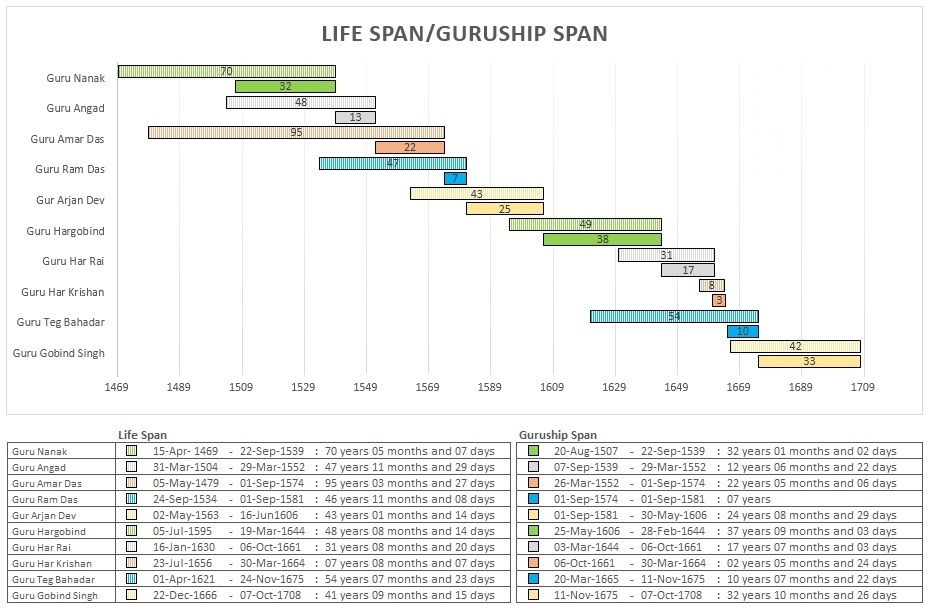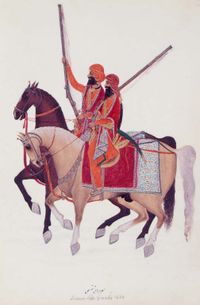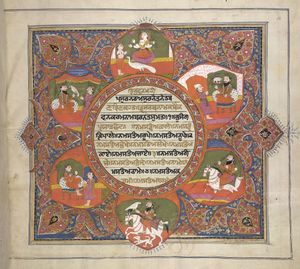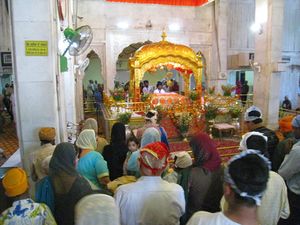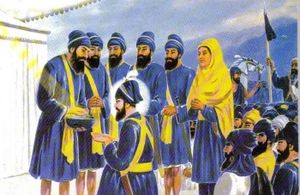سيخية
| ||||||||||||||||||||||||||||||||
| ||||||||||||||||||||||||||||||||
السيخية (بالپنجابي: ਸਿੱਖੀ، /ˈsɪkɪzəm/ SIK-iz-əm) هي ديانة[8] وفلسفة[9] هندية بدأت في منطقة الپنجاب في شمال الهند[i] في أواخر القرن الخامس عشر. وهي واحدة من أحدث المجموعات الدينية الرئيسية وتـُعد خامس أكبرهم في العالم، بتعداد 25-30 مليون معتنق لها (ويُدعَوا سيخ).
Sikhism developed from the spiritual teachings of Guru Nanak (1469–1539), the faith's first guru, and the nine Sikh gurus who succeeded him. The tenth guru, Gobind Singh (1666–1708), named the Sikh scripture Guru Granth Sahib as his successor, bringing to a close the line of human gurus and establishing the scripture as the 11th and last eternally living guru, a religious spiritual/life guide for Sikhs.[10][11][12] Guru Nanak taught that living an "active, creative, and practical life" of "truthfulness, fidelity, self-control and purity" is above metaphysical truth, and that the ideal man "establishes union with God, knows His Will, and carries out that Will".[13] Guru Hargobind, the sixth Sikh Guru (1606–1644), established the concept of mutual co-existence of the miri ('political'/'temporal') and piri ('spiritual') realms.
The Sikh scripture opens with the Mul Mantar or alternatively spelled "Mool Mantar" (بالپنجابي: ਮੂਲ ਮੰਤਰ), fundamental prayer about Ik Onkar (بالپنجابي: ੴ).[14][15] The core beliefs of Sikhism, articulated in the Guru Granth Sahib, include faith and meditation in the name of the one creator; divine unity and equality of all humankind; engaging in seva ('selfless service'); striving for justice for the benefit and prosperity of all; and honest conduct and livelihood while living a householder's life.[16][17][18] Following this standard, Sikhism rejects claims that any particular religious tradition has a monopoly on Absolute truth.[ii][19] Sikhism emphasizes simran (بالپنجابي: ਸਿਮਰਨ, meditation and remembrance of the teachings of Gurus),[20] which can be expressed musically through kirtan, or internally through naam japna ('meditation on His name') as a means to feel God's presence. It teaches followers to transform the "Five Thieves" (i.e., lust, rage, greed, attachment, and ego).[21]
The Definition of Sikh is any human being who faithfully believes in:[22]
I. One Immortal Being,
II. Ten Gurus, from Guru Nanak Sahib to Guru Gobind Singh Sahib,
III. The Guru Granth Sahib,
IV. The utterances and teachings of the ten Gurus and,
V. The baptism bequeathed by the tenth Guru, and who does not owe allegiance to any other religion, is a Sikh.
The religion developed and evolved in times of religious persecution, gaining converts from both Hinduism and Islam.[23] Mughal rulers of India tortured and executed two of the Sikh gurus—Guru Arjan (1563–1605) and Guru Tegh Bahadur (1621–1675)—after they refused to convert to Islam. The persecution of Sikhs triggered the founding of the Khalsa by Guru Gobind Singh in 1699 as an order to protect the freedom of conscience and religion,[24][25] with members expressing the qualities of a Sant-Sipāhī ('saint-soldier').
بالدعوة لاتباع تعليمات گورو ناناك و خلفائه التسعة من الگورو البشر. لقب گورو يعني بالهندية المعلم. فالسيخ هم مجموعة من الهنود دعوا إلى دين جديد فيه شيء من الديانتين الهندوسية والإسلام تحت شعار (لا هندوس ولا مسلمون) وقد عادوا المسلمين والهندوس وكانوا شديدي الولاء للبريطانيين خلال فترة استعمار الهند. مؤسسها الأول هو ناناك ويسمونه "گورو" أي المعلم ولد سنة 1469، بالقرب من لاهور، پاكستان، في بلدة تسمى الآن "ناناك صاحب". وكان قد نشأ نشأة هندوسية وعمل لدى المسلمين وكان محباً للاسلام من جهة ومشدود لتربيته الهندوسية مما دفعه للتقريب بين الديانتين.
مصطلحات

1. Golden Temple, Akaal Takht 2. Kesgarh Sahib 3. Damdama Sahib 4. Patna Sahib 5. Hazur Sahib 6. Panja Sahib 7. Nankana Sahib 8. Dera Sahib 9. Ber Sahib 10. Kartarpur Sahib, Dera Baba Nanak 11. Hemkund Sahib 12. Sis Ganj Sahib

The majority of Sikh scriptures were originally written in the alphabet of Gurmukhī, a script standardised by Guru Angad out of Laṇḍā scripts historically used in present-day Pakistan and North India.[26][27] Adherents of Sikhism are known as Sikhs, meaning 'students' or 'disciples' of the Guru. The English word Sikhism derives from the Punjabi verb Sikhi (بالپنجابي: ਸਿੱਖੀ Sikkhī, [ˈsɪk.kʰiː](![]() استمع), from بالپنجابي: ਸਿੱਖ),[iii] which connotes the "temporal path of learning" and is rooted in the word sikhana ('to learn').[28][29]
استمع), from بالپنجابي: ਸਿੱਖ),[iii] which connotes the "temporal path of learning" and is rooted in the word sikhana ('to learn').[28][29]
الفلسفة والتعاليم
- الدعوة للتوحيد وتحريم عبادة الأصنام. ففي الكتاب المقدس {إن براهما خرج من سرة فشنو (وكلاً من برهما وفشنو من آلهة الهندوس، فبراهما هو الخالق عندهم وشنو أو فيشنو هو الإله الحافظ لأمر العالم)}
- وحدة الوجود: فيعتقد أن المخلوقات برزت من مادة الإله ولذلك فغاية المنى عند الهندوسي أن يتحد بالإله.
- التأكيد على وحدانية الخالق الذي لا يموت.
- منع تمثيل الاله في صور.
- إباحة الخمر ولحم الخنزير ولحم البقر.
- للمعلم (گورو) درجة دينية تأتي بعد مرحلة الرب.
- يعتقد بأن روح كل واحد من المعلمين تنتقل إلى المعلم الذي يليه.
- الإيمان بالنبوة والرسالة: وأن الله يبعث إلى عباده رسلا يهدونهم ويدلونهم إلى طريق الخير والصلاح، وهذا قريب من معتقد المسلمين، أما الهندوس فيؤمنون بأن الله إذا أراد هداية خلقه نزل إليهم في صورة بشر لإنقاذهم، وقد تسرَّب القول بألوهية المصلح إلى السيخ من قبل زعيمهم (أرجن داس) المتوفي سنة 1601م، والذي أعلن القول بألوهية جميع المصلحين السابقين ابتداء ب(ناناك) مؤسس السيخية وانتهاء به، وجاء المصلحون من بعده فادعوا لأنفسهم مثل ما ادعى لنفسه.
- التزوج من زوجة واحدة فقط.
- تحريم الرهبنة: حيث يجب على أتباع الطائفة السعي لطلب الرزق، على خلاف مذهب الهندوس الذي يرغب أتباعه في الرهبنة وترك العمل والسلبية في الحياة.
- الدعوة إلى الوحدة بين الهندوس والمسلمين ورفع شعار " لا هندوس لا مسلمون " يقول الزعيم السيخي گوبند سنغ : " لا فرق بين مندير " معبد الهندوس " ومسجد وبين عبادة الهنادك وصلاة المسلمين ".
- المحافظة على التزام القواعد الخمس وهي بمثابة الهدي الظاهر لهم، ويرمز لها بال"5 كافات" (وذلك لانها كلها تبدأ بحرف الكاف) وهي :
الخمسة كاكارس أو الكافات الخمسة
- " الكيشو" ومعناها إطالة شعر الرأس واللحية وعدم حلقهما.
- "الكانگا" وهو عبارة عن تضفير الشعر وتركه مجدولا عوضا عن مشطه.
- " الكانشا " وتعني لبس سروال متسع يضيق عند الركبتين، وتحريم لباس "دهوتي"، وهو الرداء الذي يلبسه الهندوس، وطوله ستة أمتار، يلف حول الجسد من تحت السرة.
- "الكارا" وهو سوار من حديد يلف حول المعصم، ويحرم لبس جميع أنواع الحلي والجواهر.
- "الكربان" وهو خنجر يحمله السيخي للتحلى به، وليحمي به نفسه من أعدائه.
 گورو ناناك ديف، مؤسس السيخية. |
الگوروهات العشرة وسلطاتهم
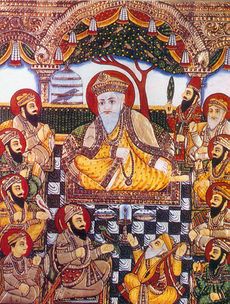
The term Guru comes from the Sanskrit gurū, meaning teacher, enlightener, guide, or mentor. The traditions and philosophy of Sikhism were established by ten Gurus from 1469 to 1708.[30][31] Each Guru added to and reinforced the message taught by the previous, resulting in the creation of the Sikh religion. Guru Nanak was the first Guru and appointed a disciple as successor. Guru Gobind Singh was the final Guru in human form. Before his death, Guru Gobind Singh decreed in 1708, that the Gurū Granth Sāhib would be the final and perpetual Guru of the Sikhs.[12]
Guru Nanak stated that his Guru is God who is the same from the beginning of time to the end of time.[32] Nanak said to be a God's slave and servant, but maintained that he was only a guide and teacher.[33][34] Nanak stated that the human Guru is mortal, who is to be respected and loved but not worshipped.[33] When Guru, or SatGuru (The true Guru) is used in Gurbani it is often referring to the highest expression of truthfulness.[35]
Guru Angad succeeded Guru Nanak. Later, an important phase in the development of Sikhism came with the third successor, Guru Amar Das. Guru Nanak's teachings emphasised the pursuit of salvation; Guru Amar Das began building a cohesive community of followers with initiatives such as sanctioning distinctive ceremonies for birth, marriage, and death. Amar Das also established the manji (comparable to a diocese) system of clerical supervision.[36]
Guru Amar Das's successor and son-in-law Guru Ram Das founded the city of Amritsar, which is home of the Harimandir Sahib and regarded widely as the holiest city for all Sikhs. Guru Arjan was arrested by Mughal authorities who were suspicious and hostile to the religious community he was developing.[37] His persecution and death inspired his successors to promote a military and political organization of Sikh communities to defend themselves against the attacks of Mughal forces.[بحاجة لمصدر]

The Sikh gurus established a mechanism which allowed the Sikh religion to react as a community to changing circumstances. The sixth guru, Guru Hargobind, was responsible for the creation of the concept of Akal Takht (throne of the timeless one), which serves as the supreme decision-making centre of Sikhism and sits opposite the Harmandir Sahib. The Akal Takht is located in the city of Amritsar. The leader is appointed by the Shiromani Gurdwara Pabandhak Committee (SPGC). The Sarbat Ḵẖālsā (a representative portion of the Khalsa Panth) historically gathers at the Akal Takht on special festivals such as Vaisakhi or Hola Mohalla and when there is a need to discuss matters that affect the entire Sikh nation. A gurmatā (literally, 'guru's intention') is an order passed by the Sarbat Ḵẖālsā in the presence of the Gurū Granth Sāhib. A gurmatā may only be passed on a subject that affects the fundamental principles of Sikh religion; it is binding upon all Sikhs.[38] The term hukamnāmā (literally, 'edict' or 'royal order') is often used interchangeably with the term gurmatā. However, a hukamnāmā formally refers to a hymn from the Gurū Granth Sāhib which is given order to Sikhs.[بحاجة لمصدر]
The word guru in Sikhism also refers to Akal Purkh (God), and God and guru can sometimes be synonymous in Gurbani (Sikh writings).[30][39]
التاريخ
أما حياة المعلم ناناك، فثمة مادة غزيرة لا تزال حتى الآن أكثر المنشورات الپنجابية شعبية، وتسمى جنام ساخي أي شواهد الميلاد، وهي أقرب إلى سير حياة القديسين الورعين.ref>عبد الحميد صالح. "السيخ". الموسوعة العربية. Retrieved 2015-03-15.</ref>
ولد المعلم ناناك عام 1469 في قرية تلفاندي جنوب غربي لاهور، واسمها اليوم ننكانا-صاحب، وفيها قضى طفولته وشبابه ثم انتقل إلى سلطان بور وغادرها عام 1500، وعاش حياة الزهاد المتجولين، إلى أن تبرع له شخص بقطعة أرض على ضفاف نهر راڤي أقام عليها قريته كارتربور التي مات فيها عام 1539.
تعرض تعاليم ناناك عادة على أنها تلفيق من تراث الهندوس وإيمان المسلمين، أي خليط من الهندوسية والإسلام، وإن كان هذا يعد تبسيطاً مسرفاً يجب رفضه، فقد وجدت في عصر ناناك عناصر متنوعة من الإيمان الديني تسمى نرگونا سمبراديا، وأحياناً تسمى تراث سانت للهند الشمالية، وكان كابير أعظم شارح لهذا التراث قبل ناناك، وكثيراً ما يتم الخلط بين هذا التراث وتراث «فشنافا بختي» المخصص لعبادة تجسيدات فشتو، لكنهما ليسا شيئاً واحداً على الإطلاق، وقد أضيف إلى تراث فشنافا عنصران؛ اليوجا التنترية، إلى جانب قدر من التصوف الإسلامي، مما ألّف نمطاً من الإيمان يؤكد أهمية الخصائص الفشنافية في عبادة المحبة، ويختلف عن الفشنافية بختي في عدة نقاط، حيث رفضت نظرية الأفتار Avatar التجسيد الإلهي، واستخفت بعبادة الأصنام وتمسكت بالعبادة الباطنية كطريق لا يمكن أن يأمل السير فيه سوى قلة قليلة.
ومع بداية أول مؤلف من كتب السيخ المقدسة يتبين أن الرقم 1 يمثل وحدانية الله، وهو مفهوم فسره المعلم ناناك تفسيراً واحدياً، فالله واحد وشخصي، وهو الخالق المفارق المتعالي، أمل الباحثين عن الخلاص، ويعبر عنه المعلم ناناك بعدة مصطلحات مثل: نرنكر أي الواحد الذي لا شكل له، والصفة الثانية لله هي آكال أي الأزلي، والصفة الثالثة هي ألاخ أي ما لا يوصف أو ليس كمثله شي، وفي كل حال لا يستطيع المرء برأي ناناك أن يعرف الله لأن الله في كماله يجاوز فهم الموجودات الفانية، ولكن تتاح للمتأمل استنارة تدريجية تؤدي في النهاية إلى الخلاص، وعند نقطة تجلي الوحي في الخلق يتم الاتصال بين الله وبين الموجودات البشرية، ومما يعوق السعي إلى الخلاص هو الوضع البشري الخاضع لعبودية العالم المادي وقيمه التي تسجنهم داخل دورة تناسخ لا نهاية لها من الميلاد والموت، والعدو العظيم هو المايا أي اللاواقع، لا واقعية القيم، لأن العالم يقدم كيفيات يقبلها الناس على أنها خيّرة ومرغوب فيها مع أنها وهم وخداع، والذين يقبلون العالم على هذا النحو هم ضحايا المايا، المحرومون من الفرح الأزلي بالرؤية السعيدة والكشف الإلهي الذي يعبر عنه المعلم ناناك بمصطلحات يستخدمها مثل، نام أي الاسم الإلهي وسهاباد أي الكلمة الإلهية وگورو أي المرشد الإلهي، وحكام أي النظام الإلهي، ويعجز الناس في حال الضلال وعدم التوبة عن إدراك تجليات الحضور الإلهي التي يوضحها المعلم الروحي غورو ونتيجة التطبيق المنظم لمصطلح نام سيمرام أي تذكر اسم الله، يكون السمو نحو الله بسلسلة من المراحل آخرها المسماة عالم الحقيقة ساخ كهاند حيث تتحد الروح بالله وتلغى أغلال التناسخ وتبلغ الروح مرحلة الانعتاق المطلق، وكان أتباع المعلم يسمون «ناناك بانتير» أي المتحدين مع ناناك، ولكن سرعان ما حملوا اسم السيخ، ومعناه الحرفي المعلم أو التلميذ، وقد حافظ المعلم الثاني أنگاد على تعاليم ناناك، وفي عهد خليفته عمار داس، أقيمت احتفالات خاصة للميلاد والزواج والموت، وتأسس نظام للرقابة الرعوية هو نظام مانجي وجعلت إقامة المعلم في مدينة گوندڤال منها مركزاً لحج السيخ.
الكتب المقدسة
آدي گرانت
المعلم أرجان هو الذي جمع الكتاب المقدس آدي گرانت أو گرانت صاحب، وإبان حكم الامبراطور المغولي المسلم جهانكير قبض على المعلم أرجان ومات في السجن عام 1606، وفي عام 1699 أسس المعلم الروحي جوبند سنغ الخلسا أو نظام الأبرار، وهو نوع من الأخويات تندمج فيه الواجبات الدينية والعسكرية مع الواجبات الاجتماعية، ومن السمات الرئيسة لهذا النظام وجود عدد من المحرمات، مثل: تحريم تدخين الغليون،
گورو گرانت صاحب

ينسب الگورو گرانت صاحب إلى مؤسس السيخية ناناك.
دسام گرانت
راحت نامة
كتاب راحت نامة ويحتوي على آداب وتقاليد الخالصدال وهي طائفة من الشباب التزمت بنظام سلوكي قاس، حيث ينصرفون إلى العبادة والقتال من أجل الحق والعدل الذي يعتقدونه . وتتركز عبادتهم بترديد الأناشيد من كتبهم المقدسة، وهكذا أراد ناناك الجمع بين سمو تعاليم دين الإسلام وتقليد الآباء.
الاحتفالات
يسمى العيد الرئيسي للسيخ ديفالي او ديوالي و هذاالعيد يحتفل به الهندوس أيضا.حيث يكون هذا العيد في فصل الخريف .
المهرجانات والأحداث السيخية
المراسم والتقاليد
المعبد السيخي
الهيكل الذهبي هو معبد السيخ الرئيسي في الهند ومحجتهم الأولى. يقع في مدينة أمريتسار في ولاية البنجاب. وهو مبنى رخامي مربع ذو قبة نحاسية مذهبة, وأبواب قائمة في جوانبه الأربعة. تم تشييده في العام 1604 للميلاد.
المعمودية والخلسا
اللقاء مع الأسرة الأكبر، الخلسا، أي أخوية الأبرار في المعبد الگوردوارا، وعندما يدخل السيخ إلى المعبد يتجه نحو الكتاب المقدس الغوروجرانت ويلمس الأرض بجبهته ويقدم قرباناً، ثم يشترك مع الآخرين في الصلاة أي تلاوة الأرداس وهي ابتهالات للنعمة الإلهية تنتهي بالقول: أن الخلسا سوف تحكم (راج كاريگا خلسا).
السيخ
رجل السيخ هو المتعلم، وهو تابع لگورو ناناك وخلفائه، وقد عُرف المذهب عند السيخ أنفسهم باسم الگورمات، وعرفه الغرب باسم السيخ، والمؤلفات التي تتحدث عن تقسيمات السيخ هي مضللة في فهم الطبيعة الحقّة لديانة السيخ ومجتمعهم، لاسيما في شمال الهند، فثمة خيوط طبقية مشتركة تجري أفقياً في مجتمع الهندوس والسيخ من الناحية العَقَدية، وإذا كان مذهب السيخ لا يتوحد تماماً مع التراث الهندوسي، فإنه لا يتميز عنه، ويلاحظ مقياس التوحد في فكر المعلم ناناك الذي يقبل تصورات مثل عقيدة التناسخ، كما يلاحظ التمييز في رفض بعض الموضوعات الهندوسية العامة، مثل الدلالة الدينية للتقسيمات المغلقة للطبقات، وفي عقيدة الأخوة بين السيخ أو الخلسا.
شتات السيخ
يقدر تعدادالسيخ حول العالم بـ 23 مليون نسمة يتواجد 90% منهم في ولاية البنجاب غرب الهند حيث يشكلون 65% من عدد سكان الولاية. بينما تنتشر تجمعات كبيرة للسيخ في ولايات هندية أخرى حيث يشكل السيخ 2% من عدد سكان الهند وتتواجد تجمعات أصغر في باكستان و أفغانستان. كما يتواجد السيخ في أجزاء متفرقة من العالم كنتيجة طبيعية للهجرة.حيث بدات هجرة السيخ الأولى خارج مناطق تواجدهم التقليدية في بدايات القرن التاسع عشر.حيث تتواجد تجمعات للسيخ في كندا ( برومبتون ، أونتاريو ، بريتيش كولومبيا ، سرْي ) ، الشرق الأوسط(الأمارات ، عُمان ، الكويت ،البحرين ) ، المملكة المتحدة ، شرق افريقيا(كينيا) ،جنوب شرق أسيا(ماليزيا) كما بدأت هجرة أحدث نسبيا إلى الولايات المتحدةالأمريكية ، فرنسا وبعض دول غرب اوروپا ، أستراليا، نيوزلندا. كما تتواجد تجمعات أصغر للسيخ في نيپال، ڤيجي، سريلانكا و موريشيوس.
المحرمات في السيخية
 مقالات مفصلة: المحرمات في السيخية
مقالات مفصلة: المحرمات في السيخية- النظام الغذائي في السيخية
انظر أيضاً
ملاحظات
- ^ "Hinduism, Buddhism, Jainism and Sikh originated in India." Moreno, Luis; Colino, César (2010). Diversity and Unity in Federal Countries. McGill Queen University Press. p. 207. ISBN 978-0-7735-9087-8.
- ^ "Sikhism rejects the view that any particular religious tradition has a monopoly regarding Absolute Truth. Sikhism rejects the practice of converting people to other religious traditions." Kalsi, Sewa Singh (2008). Sikhism. London: Kuperard. p. 24. ISBN 978-1-85733-436-4.
- ^ Sikhism (commonly known as Sikhī) originated from the word Sikh, which comes from the Sanskrit root śiṣya meaning "disciple", or śikṣa meaning "instruction". Singh, Khushwant. 2006. The Illustrated History of the Sikhs. Oxford University Press. ISBN 978-0-19-567747-8. p. 15.Kosh, Gur Shabad Ratnakar Mahan. https://web.archive.org/web/20050318143533/http://www.ik13.com/online_library.htm
المصادر
- ^ Nesbitt, Eleanor (2016). Sikhism: A Very Short Introduction. OUP Oxford. ISBN 9780191062773.
From the rest of this introduction to the Guru Granth Sahib, and from Guru Nank's compositions, it is a monotheistic, rather than a monist, view of God which emerges.
- ^ Takhar, Opinderjit Kaur (2016). Sikh Identity: An Exploration of Groups Among Sikhs. Routledge. ISBN 9781351900102.
Since the Sikh concept of the divine is panentheistic, the divine is always greater than the created universe, its systems such as karma and samsara, and all phenomena within it. In Sikhism, due to the sovereignty of God, the doctrines of Nadar and Hukam override all systems, both concepts reinforcing panentheism. Hence one becomes a jivanmukt only in accordance with the Hukam.
- ^ Reynolds, William M.; Webber, Julie A. (2004). Expanding Curriculum Theory: Dis/positions and Lines of Flight. Routledge. p. 90. ISBN 9781135621278.
Like the God-of-process theologians in the West (Whitehead, Cobb, Griffin, Hartshorne), the God of Sikhism is a dynamic God, a process moving within humankind, pervasive within the hearts of people, yet transcendent and eternal. The Sikh God is one with whom devotees become wholly absorbed: "As the fish, I find the life of absorption in the water that is God" (Sri Guru Granth. 1988, p. 166). As the fish is absorbed in the water that is God, the soul is absorbed in the lightness that is God. The fish, even though absorbed in the water that is God, does not lose its fishness, its fish identity-formation, even though absorbed in the light that is God. A panentheistic system, such as Sikhsim, allows the soul to retain its soulness while merging with God. The soul, in other words, is not identical with God, even after merging with God, but one might say God is part of the soul. A strict identity soul = God is incarnationism and this is considered anathema in Sikhism. The Granth uses the beloved/lover metaphor for the relation of the self to God. God is the beloved and the devo tee is the lover. The lover retains her identity yet merges with her beloved.
- ^ Singh, Pashaura; Mandair, Arvind-Pal Singh (2023). The Sikh world. London New York: Routledge. ISBN 9780429848384.
In looking at the teachings of the Gurus as a whole, it seems that Lourdunathan overstates the degree to which Sikh scripture is anti-monistic. Guru Nanak famously referred to the world as a "palace of smoke" (GGS: 138) and made countless references to the idea of maya (Illusion). While the Gurus did not teach a radical nondualism, it is perhaps more accurate to suggest that some aspects of Sikh thought constitute a qualified nondualism (in which Creator and Creation are part of the same whole) (GGS: 125) or panentheism (in which the Creator pervades the natural world) (GGS: 24), while many others are monotheistic, including passages in Japji Sahib, where God is described as the King of Kings (GGS: 6). These different interpretations lend themselves to varying understandings of the relationship between the natural world and divinity.
- ^ Mann, Gurinder Singh (2001). The Making of Sikh scripture. Oxford: Oxford University Press. p. 5. ISBN 9780195130249.
- ^ The Oxford Handbook of Sikh Studies. Oxford Handbooks. Pashaura Singh, Louis E. Fenech. OUP Oxford. 2014. p. 380. ISBN 9780191004117.
{{cite book}}: CS1 maint: others (link) - ^ "Sikhism".
- ^ Charles Joseph Adams. "classification of religions". Encyclopædia Britannica (in الإنجليزية). Archived from the original on 7 July 2015. Retrieved 30 July 2022.
- ^ Singh, Pashaura; Fenech, Louis E., eds. (2014). The Oxford Handbook of Sikh Studies. Oxford University Press. pp. 299–301. ISBN 978-0-19-969930-8.
- ^ Fenech, Louis, and William Hewat McLeod (2014). Historical Dictionary of Sikhism (3rd ed.). Rowman & Littlefield. ISBN 978-1-4422-3600-4. pp. 17, 84–5.
- ^ James, William (2011). God's Plenty: Religious Diversity in Kingston. McGill–Queen's University Press. ISBN 978-0-7735-3889-4. pp. 241–42.
- ^ أ ب Mann, Gurinder Singh (2001). The Making of Sikh Scripture. Oxford University Press. pp. 21–25, 123–24. ISBN 978-0-19-513024-9.
- ^ Marwaha, Sonali Bhatt (2006). Colors of Truth: Religion, Self and Emotions: Perspectives of Hinduism, Buddhism, Jainism, Zoroastrianism, Islam, Sikhism and Contemporary Psychology. Concept Publishing. pp. 205–206. ISBN 978-81-8069-268-0.
- ^ Singh, Pashaura (2003). The Guru Granth Sahib: Canon, Meaning and Authority. Oxford University Press. pp. 101–102. ISBN 978-0-19-908773-0.
- ^ خطأ استشهاد: وسم
<ref>غير صحيح؛ لا نص تم توفيره للمراجع المسماةsinghaikonkar - ^ Kalsi, Sewa Singh (2005). Sikhism. Religions of the World. Philadelphia: Chelsea House Publishers. pp. 41–50. ISBN 0-7910-8098-6.
- ^ Cole, William Owen; Sambhi, Piara Singh (1995). The Sikhs: Their Religious Beliefs and Practices. Sussex Academic Press. p. 200.
- ^ Teece, Geoff (2004). Sikhism: Religion in focus. Black Rabbit Books. p. 4. ISBN 978-1-58340-469-0.
- ^ Reichberg, Gregory M.; Syse, Henrik (2014). Religion, War, and Ethics: A Sourcebook of Textual Traditions. Cambridge University Press. pp. 672–674. ISBN 978-1-139-95204-0.
- ^ Pattanaik, Devdutt (2019). "Where Hinduism and Sikhism meet". Mumbai Mirror.
- ^ Nayar, Kamala Elizabeth; Sandhu, Jaswinder Singh (2012). The Socially Involved Renunciate: Guru Nanak's Discourse to the Nath Yogis. State University of New York Press. p. 106. ISBN 978-0-7914-7950-6.
- ^ Rehat Maryada Archived 1 يناير 2016 at the Wayback Machine
- ^ Singh, Pritam (2008). Federalism, Nationalism and Development: India and the Punjab Economy. Abingdon-on-Thames, England: Routledge. ISBN 978-1-134-04945-5.
A large number of Hindu and Muslim peasants converted to Sikhism from conviction, fear, economic motives, or a combination of the three (Khushwant Singh 1999: 106; Ganda Singh 1935: 73).
- ^ خطأ استشهاد: وسم
<ref>غير صحيح؛ لا نص تم توفيره للمراجع المسماةpashauraarjan - ^ خطأ استشهاد: وسم
<ref>غير صحيح؛ لا نص تم توفيره للمراجع المسماةGandhi - ^ Bahri, Hardev. "Gurmukhi". Encyclopaedia of Sikhism. Punjabi University Patiala. Retrieved 9 April 2016.
- ^ Shackle, Christopher; Mandair, Arvind (2013). Teachings of the Sikh Gurus: Selections from the Sikh Scriptures. Abingdon-on-Thames, England: Routledge. pp. xxi–xxiii. ISBN 978-1-136-45101-0.
- ^ Mandair, Arvind-Pal Singh (2013). Sikhism: A Guide for the Perplexed. Bloomsbury Academic. pp. 3, 12–13. ISBN 978-1-4411-0231-7.
- ^ Chahal, Devinder (July–December 2006). "Understanding Sikhism in the Science Age" (PDF). Understanding Sikhism: The Research Journal (2): 3. Retrieved 10 November 2013.
- ^ أ ب Singh, Darshan (1968). Indian Bhakti Tradition and Sikh Gurus. Chandigarh: Panjab Publishers. p. 158.
- ^ Nesbitt, Eleanor (22 September 2005). Sikhism: A Very Short Introduction. Oxford University Press. p. 22. ISBN 978-0-19-157806-9.
- ^ Gandhi, Surjit Singh (1 February 2008). History of Sikh Gurus Retold: 1469–1606 C.E. New Delhi: Atlantic Publishers. p. 265. ISBN 978-81-269-0857-8.
- ^ أ ب Singh, Khushwant (1969). Hymns of Guru Nanak. Orient Blackswan. p. 116. ISBN 978-81-250-1161-3.
- ^ Gandhi, Surjit Singh (2007). History of Sikh Gurus Retold: 1469–1606 C.E. New Delhi: Atlantic Publishers. p. 265. ISBN 978-81-269-0859-2.
- ^ Singh, Darshan (1968). Indian Bhakti Tradition and Sikh Gurus. Chandigarh: Panjab Publishers. p. 148.
- ^ خطأ استشهاد: وسم
<ref>غير صحيح؛ لا نص تم توفيره للمراجع المسماةp254 - ^ Parrinder, Geoffrey (1971). World Religions: From Ancient History to the Present. London: Hamlyn. p. 255. ISBN 978-0-87196-129-7.
- ^ "Sikh Reht Maryada – Method of Adopting Gurmatta". Archived from the original on 6 June 2002. Retrieved 9 June 2006.
- ^ Raj, Selva (2013). South Asian Religions: Tradition and Today. Abingdon-on-Thames, England: Routledge. p. 232. ISBN 978-0-415-44851-2.
قراءات إضافية
- Dilgeer, Dr Harjinder Singh (2008), Sikh Twareekh, publisher Sikh University Press & Singh Brothers Amritsar, 2008.
- Dilgeer, Dr Harjinder Singh (2012), Sikh History (in 10 volumes), publisher Sikh University Press & Singh Brothers Amritsar, 2010–12.
- Duggal, Kartar Singh (1988), Philosophy and Faith of Sikhism, Himalayan Institute Press, ISBN 978-0-89389-109-1
- Kaur, Surjit, Amongst the Sikhs: Reaching for the Stars, New Delhi, Roli Books, 2003 ISBN 81-7436-267-3
- Khalsa, Guru Fatha Singh, Five Paragons of Peace: Magic and Magnificence in the Guru's Way, Toronto, Monkey Minds Press, 2010, ISBN 0-9682658-2-0, gurufathasingh.com
- Khalsa, Shanti Kaur, The History of Sikh Dharma of the Western Hemisphere, Sikh Dharma, Espanola, NM, 1995 ISBN 0-9639847-4-8
- Singh, Khushwant (2006), The Illustrated History of the Sikhs, Oxford University Press, India, ISBN 978-0-19-567747-8
- Singh, Patwant (1999), The Sikhs, Random House, India, ISBN 978-0-385-50206-1
- Takhar, Opinderjit Kaur, Sikh Identity: An Exploration of Groups Among Sikhs, Ashgate Publishing Company, Burlington, VT, 2005 ISBN 0-7546-5202-5
- Teece, Geoff (2004), Sikhism: Religion in focus, Black Rabbit Books, ISBN 978-1-58340-469-0
- Dilgeer, Dr Harjinder Singh (1997), The Sikh Reference Book, publisher Sikh University Press & Singh Brothers Amritsar, 1997.
- Dilgeer, Dr Harjinder Singh (2005), Dictionary of Sikh Philosophy, publisher Sikh University Press & Singh Brothers Amritsar, 2005.
- Chopra, R. M. (2001), Glory of Sikhism, publisher Sanbun, New Delhi, ISBN 978-3-473-47119-5
- Chopra, R. M. (2014). "The Philosophical and Religious Thought of Sikhism", publisher Sparrow Publication, Kolkata, ISBN 978-81-89140-99-1.
وصلات خارجية
- CS1 maint: others
- Short description is different from Wikidata
- Portal-inline template with redlinked portals
- Pages with empty portal template
- Articles containing Punjabi-language text
- Articles with hatnote templates targeting a nonexistent page
- Articles with unsourced statements from May 2023
- سيخية
- Nirguna worship traditions
- ديانات هندية
- 1500 establishments in Asia
- Religious organizations established in the 15th century
- 15th-century establishments in India
- توحيدية
- ديانات توحيدية
- پنجاب
